

 Welcome to Yoshiro’s lab!
Welcome to Yoshiro’s lab!

Professor
Laboratory of Molecular Biology and Metabolism,
Graduate School of Pharmaceutical Sciences, Tohoku University
EDUCATION
- 2001: Ph.D. in biochemistry and cell biology, Hokkaido University, JAPAN: Thesis entitled "Structure and Function of Selenoprotein P".
- 1998: M.Sc. in biochemistry, Hokkaido University, JAPAN
- 1996: B.Sc. in pharmacy, Hokkaido University, JAPAN
PROFESSIONAL EXPERIENCE
2018-Aug 2018 Professor for Faculty of Life and Medical Sciences, Doshisha University, JAPAN
2012-2018 Associate professor for Faculty of Life and Medical Sciences, Doshisha University, JAPAN
2008-2012 Instructor for Faculty of Life and Medical Sciences, Doshisha University, JAPAN
2002-2008 Research Scientist for Human Stress Signal Research Center, National Institute of Advanced Industrial Science and Technology (AIST)
2000-2002 Research Fellow of the Japan Society for the Promotion of Science
HP
 Introduction
Introduction
Understand the metabolism of trace elements and reactive species at the molecular level, and apply their control methods to the drug discovery
Our body is constituted by many elements including trace elements that account for less than 1% of the total. The amount of trace element is quite low, but it plays a significant role in maintaining homeostasis. In our laboratory, we focus on the role of trace elements in living organisms and conduct research at the molecular level on their physiological roles, especially on their protective effects against reactive oxygen species and harmful substances. Previous studies have revealed that abnormal metabolism of trace elements is involved in diabetes, cancer, and neurodegenerative diseases. We are working on research on trace elements, developing their control methods, and leading to drug discovery.
We are conducting research using genetically modified animals such as knockout mice and cell models, by using biochemical and molecular biological techniques. We are also conducting research from the identification of disease biomarkers to the development of therapeutic methods, using comprehensive analysis techniques that have made remarkable progress in recent years. We aim to develop researchers who have advanced research technology and can be active in the world.
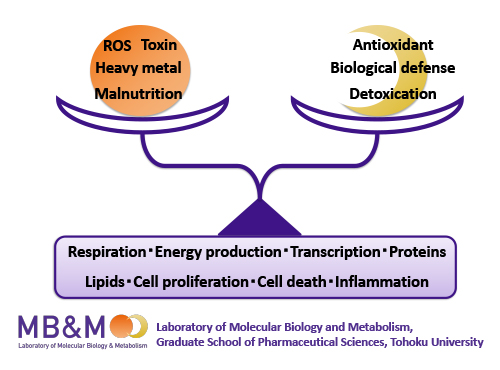
A few percent of the oxygen consumed in the process of energy production becomes “Reactive Oxygen Species (ROS)”. ROS is dangerous because it oxidizes and denatures biomolecules. Our body has an antioxidant system that removes ROS, and there is a balance between ROS generation and removal by the antioxidant system. On the other hand, it has also been revealed that ROS functions as an important signal molecule for cellular responses, and proper ROS levels on living organisms are considered. Disruption of balance due to excess ROS or antioxidants has been shown to have various effects on not only cell death and inflammation but also energy metabolism, cell growth, and transcriptional regulation. In our laboratory, we are conducting research on the importance of this balance in vivo at the molecular level, and conducting research focusing on heavy metals, toxic substances, and malnutrition as factors that disrupt the balance.
 Outline of our project
Outline of our project
Metabolism and physiological functions of essential trace element “selenium”
Selenium, an essential trace element, is highly reactive and toxic, but the living body takes in the properties of selenium and uses it for biological defense. Selenium is mainly incorporated into the proteins in the form of selenocysteine (Sec: an analog of cysteine that contains selenium instead of sulfur). The role of selenium as an essential trace element is mediated by Sec-containing proteins, namely “selenoproteins”. Twenty-five kinds of selenoproteins have been discovered in humans, including glutathione peroxidase, which reduces and detoxifies reactive oxygen species, and thioredoxin reductase, which plays a role in redox regulation via the reduction of protein disulfides (Figure 1). Sec forms the active site of these seleno-enzymes. Sec is encoded by the UGA stop codon and is also called the 21st amino acid that can be translated. In our laboratory, we aim to elucidate the metabolism of selenium, namely how selenium contained in meals are used for the synthesis of selenoproteins in the whole body. In particular, we are studying the molecular mechanism of selenium transport by plasma selenoprotein “selenoprotein P”. Selenoprotein P is mainly synthesized in the liver and secreted into the plasma. The major feature of selenoprotein P is that it has 10 Sec residues in the molecule (Fig. 2). We are studying the physiological significance and molecular mechanism of how selenium contained as Sec is transferred to cells via selenoprotein P and its receptor. In addition, the selenoproteins identified to date include molecules with unknown functions. We are also elucidating the function of selenoproteins with unknown functions.
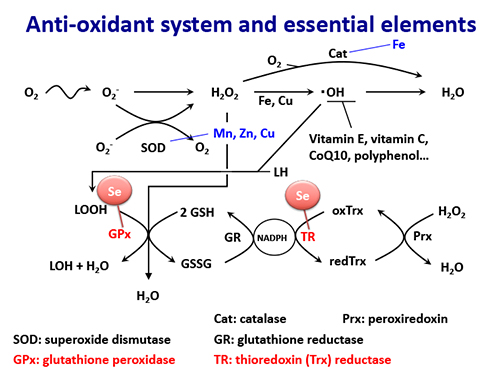
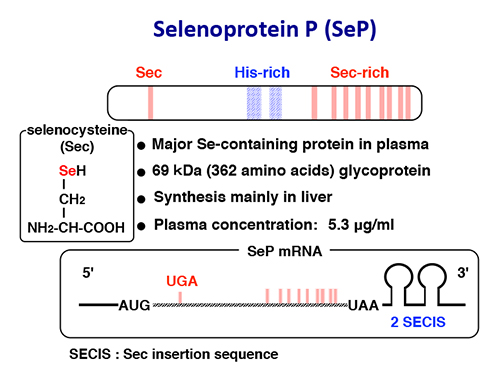
Elucidation of the molecular mechanisms of excess selenoprotein P-related disease and development of therapeutic reagents:
The selenium-containing protein “selenoprotein P” present in plasma is mainly produced in the liver and functions as a transporter of selenium that delivers it to each tissue. Selenoprotein P also functions as an antioxidant enzyme that reduces phospholipid hydroperoxide PL-OOH to a stable PL-OH. Selenoprotein P is thought to play an important role in the defense against reactive oxygen species and in the redox control by maintaining intracellular selenoprotein levels (Figure 3). However, previous studies have revealed that selenoprotein P increases in patients with type 2 diabetes, and that increased selenoprotein P induces insulin resistance in the liver and skeletal muscle and causes hyperglycemia (Figure 4). It has also been shown that excess selenoprotein P causes exercise resistance in skeletal muscle and impaired insulin secretion in the pancreas. Thus, excess selenoprotein P is an important therapeutic target for type 2 diabetes. In our laboratory, we are analyzing the deterioration mechanism of glucose metabolism caused by excess selenoprotein P. Furthermore, we are developing a method to suppress the action of excess selenoprotein P and to treat type 2 diabetes. To date, we have successfully developed a selenoprotein P neutralizing antibody, and have shown improvement in diabetic model animals (Figures 5 and 6). We are developing a system for measuring blood levels of selenoprotein P and aiming to establish a tailor-made treatment of diabetes based on selenoprotein P levels.
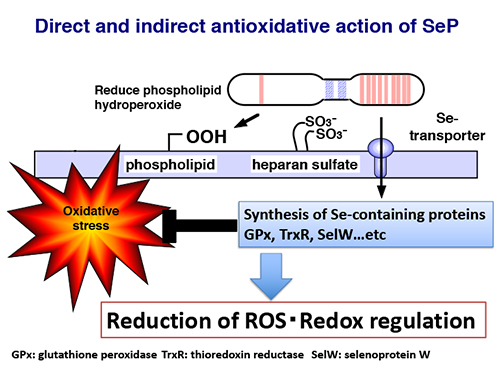
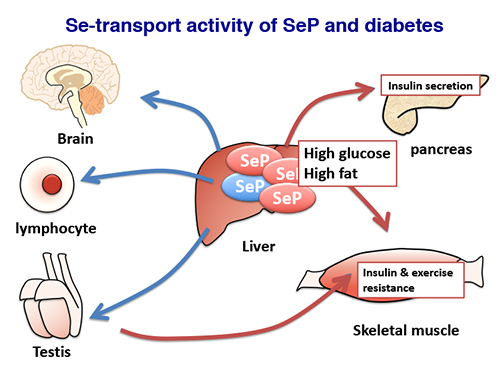
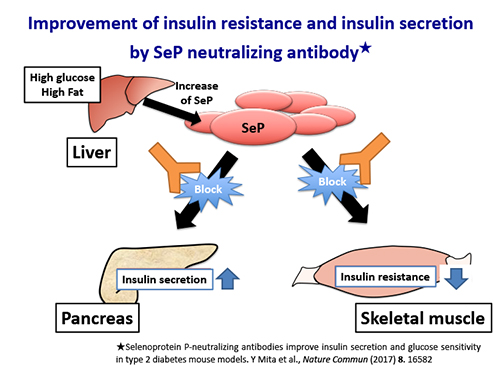
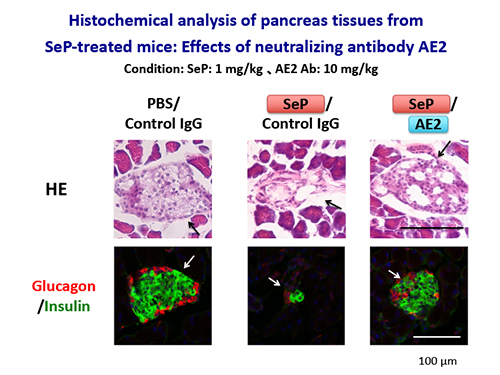
 Recruitment of graduate students and PhD candidates!
Recruitment of graduate students and PhD candidates!
If you are interested in research in our laboratory, please contact Yoshiro Saito (yoshiro.saito.a8@tohoku.ac.jp).
The Laboratory of Molecular Biology and Metabolism is located in room C301, the third floor of Building C, in Graduate School of Pharmaceutical Sciences. Please feel free to visit.
For access information to the Graduate School of Pharmaceutical Sciences, please see the following site:
http://www.pharm.tohoku.ac.jp/english/map-e.html


